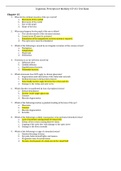Patho 2410 Study guides, Class notes & Summaries
Looking for the best study guides, study notes and summaries about Patho 2410? On this page you'll find 56 study documents about Patho 2410.
Page 4 out of 56 results
Sort by
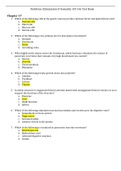
-
Exam (elaborations) PATHO 2410 (PATHO2410) PATHO 2410 Nutrition/Elimination/Sexuality Test Bank
- Exam (elaborations) • 28 pages • 2021
-
Available in package deal
-
- $15.99
- + learn more
Nutrition/Elimination & Sexuality (CP #4) Test Bank Chapter 17 1. Which of the following cells in the gastric mucosa produce intrinsic factor and hydrochloric acid? a. Parietal cells b. Chief cells c. Mucous cells d. Gastrin cells 2. Which of the following is the primary site for absorption of nutrients? a. Stomach b. Duodenum c. Ileum d. Ascending colon 3. When highly acidic chyme enters the duodenum, which hormone stimulates the release of pancreatic secretions that contains very high bicarbon...
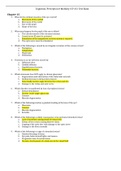
-
PATHO 2410 Cognition/Perception/Mobility Test Bank (complete solutions rated A)
- Exam (elaborations) • 19 pages • 2021
- Available in package deal
-
- $15.49
- + learn more
PATHO 2410 Cognition/Perception/Mobility Test Bank (complete solutions rated A) / PATHO 2410 Cognition/Perception/Mobility Test Bank (complete solutions rated A) / PATHO 2410 Cognition/Perception/Mobility Test Bank (complete solutions rated A)
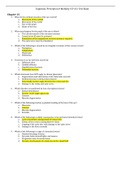
-
PATHO 2410 (PATHO2410)PATHO 2410 Cognition/Perception/Mobility Test Bank
- Exam (elaborations) • 19 pages • 2021
- Available in package deal
-
- $15.09
- + learn more
er 15 1. What do the extrinsic muscles of the eye control? a. Movement of the eyeball b. Movement of the eyelid c. Size od the pupil d. Shape of the lens 2. What must happen for the pupil of the eye to dilate? a. The circular muscle of the iris must contract. b. Cranial nerve III must be activated. c. Stimulation of the sympathetic nervous system is required. d. The optic nerve must be stimulated. 3. Which of the following is caused by an irregular curvature of the cornea or lens? a....
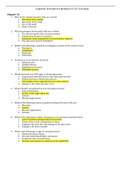
-
PATHO 2410 Cognition/Perception/Mobility ,Latest Version 2021
- Exam (elaborations) • 19 pages • 2021
-
- $14.49
- + learn more
PATHO 2410 Cognition/Perception/Mobility ,Latest Version 2021PATHO 2410 Cognition/Perception/Mobility ,Latest Version 2021PATHO 2410 Cognition/Perception/Mobility ,Latest Version 2021

-
PATHOPHYSIOLOGY_ PATHO 2410 Regulation Metabolism (CP2) Test Bank Exam Tested Questions and Answers (Revised 2021 Exam Study Guide)
- Exam (elaborations) • 23 pages • 2021
- Available in package deal
-
- $16.48
- + learn more
PATHOPHYSIOLOGY PATHO 2410 Regulation/Metabolism (CP #2) Test Bank Exam Tested Questions and Answers Chapter 2 1. Choose the correct proportion of water to body weight to be expected in a healthy male adult’s body: a. 30% b. 45% c. 60% d. 70% 2. Choose the correct proportion of blood (to body weight) in an adult male’s body: a. 30% b. 20% c. 10% d. 4% 3. Insensible fluid loss refers to water lost through: a. Perspiration only b. Feces only c. Perspiration and expiration d. Urine...
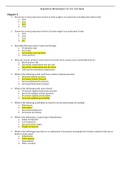
-
PATHO 2410 (PATHO2410)Regulation/Metabolism Test Bank
- Exam (elaborations) • 23 pages • 2021
- Available in package deal
-
- $15.99
- + learn more
egulation/Metabolism (CP #2) Test Bank Chapter 2 1. Choose the correct proportion of water to body weight to be expected in a healthy male adult’s body: a. 30% b. 45% c. 60% d. 70% 2. Choose the correct proportion of blood (to body weight) in an adult male’s body: a. 30% b. 20% c. 10% d. 4% 3. Insensible fluid loss refers to water lost through: a. Perspiration only b. Feces only c. Perspiration and expiration d. Urine and feces 4. When the osmotic pressure of the blood is el...
PATHO 2410 Cognition/Perception/Mobility Test Bank/PATHO 2410 Cognition/Perception/Mobility Test Bank

-
PATHOPHYSIOLOGY_ PATHO 2410 Cognition Perception & Mobility (CP #5) Test Bank Exam Tested Questions and Answers (Revised 2021 Exam Study Guide)
- Exam (elaborations) • 20 pages • 2021
- Available in package deal
-
- $19.48
- + learn more
PATHOPHYSIOLOGY_ PATHO 2410 Cognition Perception & Mobility (CP #5) Test Bank Exam Tested Questions and Answers (Revised 2021 Exam Study Guide)
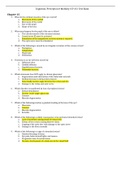
-
Exam (elaborations) PATHO 2410 (PATHO2410)PATHO 2410 Cognition/Perception/Mobility Test Bank
- Exam (elaborations) • 19 pages • 2021
-
Available in package deal
-
- $15.09
- + learn more
er 15 1. What do the extrinsic muscles of the eye control? a. Movement of the eyeball b. Movement of the eyelid c. Size od the pupil d. Shape of the lens 2. What must happen for the pupil of the eye to dilate? a. The circular muscle of the iris must contract. b. Cranial nerve III must be activated. c. Stimulation of the sympathetic nervous system is required. d. The optic nerve must be stimulated. 3. Which of the following is caused by an irregular curvature of the cornea or lens? a. Nystagmus b...
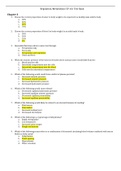
-
PATHO 2410 (PATHO2410)Regulation/Metabolism Test Bank
- Exam (elaborations) • 23 pages • 2021
-
Available in package deal
-
- $15.99
- + learn more
egulation/Metabolism (CP #2) Test Bank Chapter 2 1. Choose the correct proportion of water to body weight to be expected in a healthy male adult’s body: a. 30% b. 45% c. 60% d. 70% 2. Choose the correct proportion of blood (to body weight) in an adult male’s body: a. 30% b. 20% c. 10% d. 4% 3. Insensible fluid loss refers to water lost through: a. Perspiration only b. Feces only c. Perspiration and expiration d. Urine and feces 4. When the osmotic pressure of the blood is elevated above norm...

Do you wonder why so many students wear nice clothes, have money to spare and enjoy tons of free time? Well, they sell on Stuvia! Imagine your study notes being downloaded a dozen times for $15 each. Every. Single. Day. Discover all about earning on Stuvia



